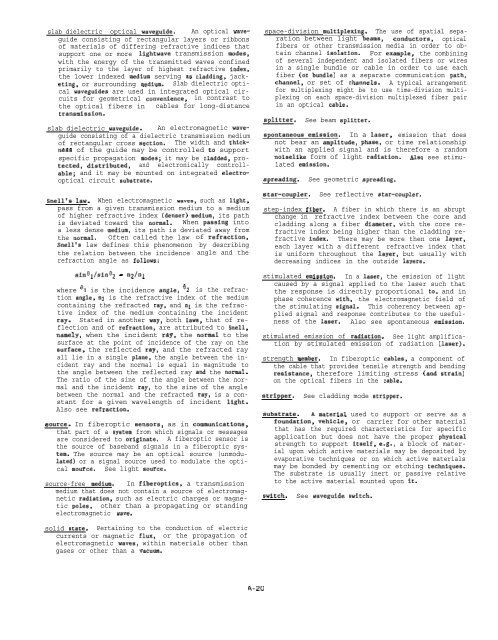FIBEROPTIC SENSOR TECHNOLOGY HANDBOOK
FIBEROPTIC SENSOR TECHNOLOGY HANDBOOK
FIBEROPTIC SENSOR TECHNOLOGY HANDBOOK
Create successful ePaper yourself
Turn your PDF publications into a flip-book with our unique Google optimized e-Paper software.
slab dielectric optical waveguide. An optical waveguide<br />
consisting of rectangular layers or ribbons<br />
of materials of differing refractive indices that<br />
support one or more lightwave transmission modes,<br />
with the energy of the transmitted waves confined<br />
primarily to the layer of highest refractive index,<br />
the lower indexed medium serving aa cladding, jacketing,<br />
or surrounding medium. Slab dielectric optical<br />
waveguides are used in integrated optical circuits<br />
for geometrical convenience, in contrast to<br />
the optical fibers in cables for long-distance<br />
transmission.<br />
slab dielectric waveguide. An electromagnetic waveguide<br />
consisting of a dielectric transmission medium<br />
of rectangular cross section. The width and thickness<br />
of the guide may be controlled to support<br />
specific propagation modes; it may be cladded, protected,<br />
distributed, and electronically controllable;<br />
and it may be mounted on integrated electrooptical<br />
circuit substrate.<br />
Snell’s law. When electromagnetic wavea, such as light,<br />
pass from a given transmission medium to a medium<br />
of higher refractive index (denser) medium, its path<br />
is deviated toward the normal. When paasing into<br />
a less dense medium, its path is deviated away from<br />
the normal. Often called the law of refraction,<br />
Snell’s law defines this phenomenon<br />
the relation between the incidence<br />
by describing<br />
angle and the<br />
refraction angle as follows:<br />
sin@l/sine2 = n2/nl<br />
where 81 is the incidence angle, ’32 is the refraction<br />
angle, n2 is the refractive index of the medium<br />
containing the refracted ray, and nl is the refractive<br />
index of the medium containing the incident<br />
ray. Stated in another way, both laws, that of reflection<br />
and of refraction, are attributed to Snell,<br />
namely, when the incident ray, the normal to the<br />
surface at the point of incidence of the ray on the<br />
surface, the reflected ray, and the refracted ray<br />
all lie in a single plane, the angle between the incident<br />
ray and the normal is equal in magnitude to<br />
the angle between the reflected ray and the normal.<br />
The ratio of the sine of the angle between the normal<br />
and the incident ray, to the sine of the angle<br />
between the normal and the refracted ray, is a constant<br />
for a given wavelength of incident light.<br />
Also see refraction.<br />
source. In fiberoptic sensors, as in communications,<br />
that part of a syatem from which signals or messages<br />
are considered to originate. A fiberoptic sensor is<br />
the source of baseband signals in a fiberoptic system.<br />
The source may be an optical source (unmodulated)<br />
or a signal source used to modulate the optical<br />
source. See light source.<br />
source-free medium. In fiberoptic, a transmission<br />
medium that does not contain a source of electromagnetic<br />
radiation, such as electric charges or magnetic<br />
poles, other than a propagating or standing<br />
electromagnetic wave.<br />
space-division multiplexing. The use of spatial separation<br />
between light beams, conductors, optical<br />
fibers or other transmission media in order to obtain<br />
channel isolation. For example, the combining<br />
of several independent and isolated fibers or wires<br />
in a single bundle or cable in order to use each<br />
fiber (or bundle) as a separate communication path,<br />
channel, or set of channels. A typical arrangement<br />
for multiplexing might be to use time-division multiplexing<br />
on each space-division multiplexed fiber pair<br />
in an optical cable.<br />
splitter.<br />
See beam splitter.<br />
~. In a laser, emission that does<br />
not bear an amplitude, phase, or time relationship<br />
with an applied signal and is therefore a random<br />
noiselike form of light radiation. Alao see stimulated<br />
emission.<br />
spreading.<br />
star-coupler.<br />
See geometric spreading.<br />
See reflective star-coupler.<br />
step-index fiber. A fiber in which there is an abrupt<br />
change in refractive index between the core and<br />
cladding along a fiber diameter, with the core refractive<br />
index being higher than the cladding refractive<br />
index. There may be more then one layer,<br />
each layer with a different refractive index that<br />
is uniform throughout the layer, but usually with<br />
decreasing indices in the outside layers.<br />
stimulated emission. In a laser, the emission of light<br />
caused by a signal applied to the laser such that<br />
the response is directly proportional to, and in<br />
phase coherence with, the electromagnetic field of<br />
the stimulating signal. This coherency between applied<br />
signal and response contributes to the usefulness<br />
of the laaer. Also see spontaneous emission.<br />
stimulated emission of radiation. See light amplification<br />
by stimulated emission of radiation (laser).<br />
strength member. In fiberoptic cables, a component of<br />
the cable that provides tensile strength and bending<br />
resistance, therefore limiting stress (and strain)<br />
on the optical fibers in the cable.<br />
stripper.<br />
See cladding mode stripper.<br />
substrate. A material used to support or serve as a<br />
foundation, vehicle, or carrier for other material<br />
that has the required characteristics for specific<br />
application but does not have the proper phyaical<br />
strength to support itself, e.g., a block of material<br />
upon which active materials may be deposited by<br />
evaporative techniques or on which active materials<br />
may be bonded by cementing or etching techniques.<br />
The substrate is usually inert or passive relative<br />
to the active material mounted upon it.<br />
switch.<br />
See waveguide switch.<br />
solid state. Pertaining to the conduction of electric<br />
currents or magnetic flux, or the propagation of<br />
electromagnetic waves, within materials other than<br />
gases or other than a vacuum.<br />
A-20
















